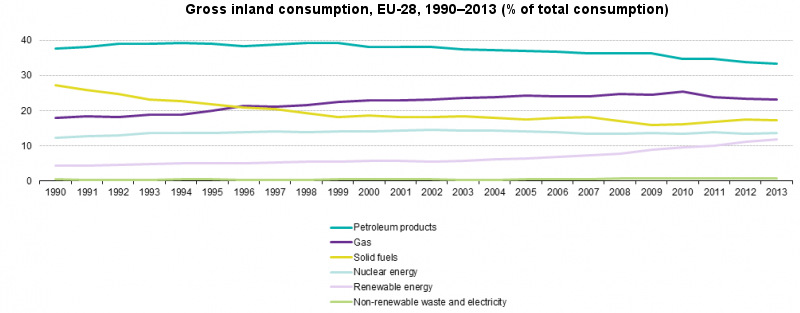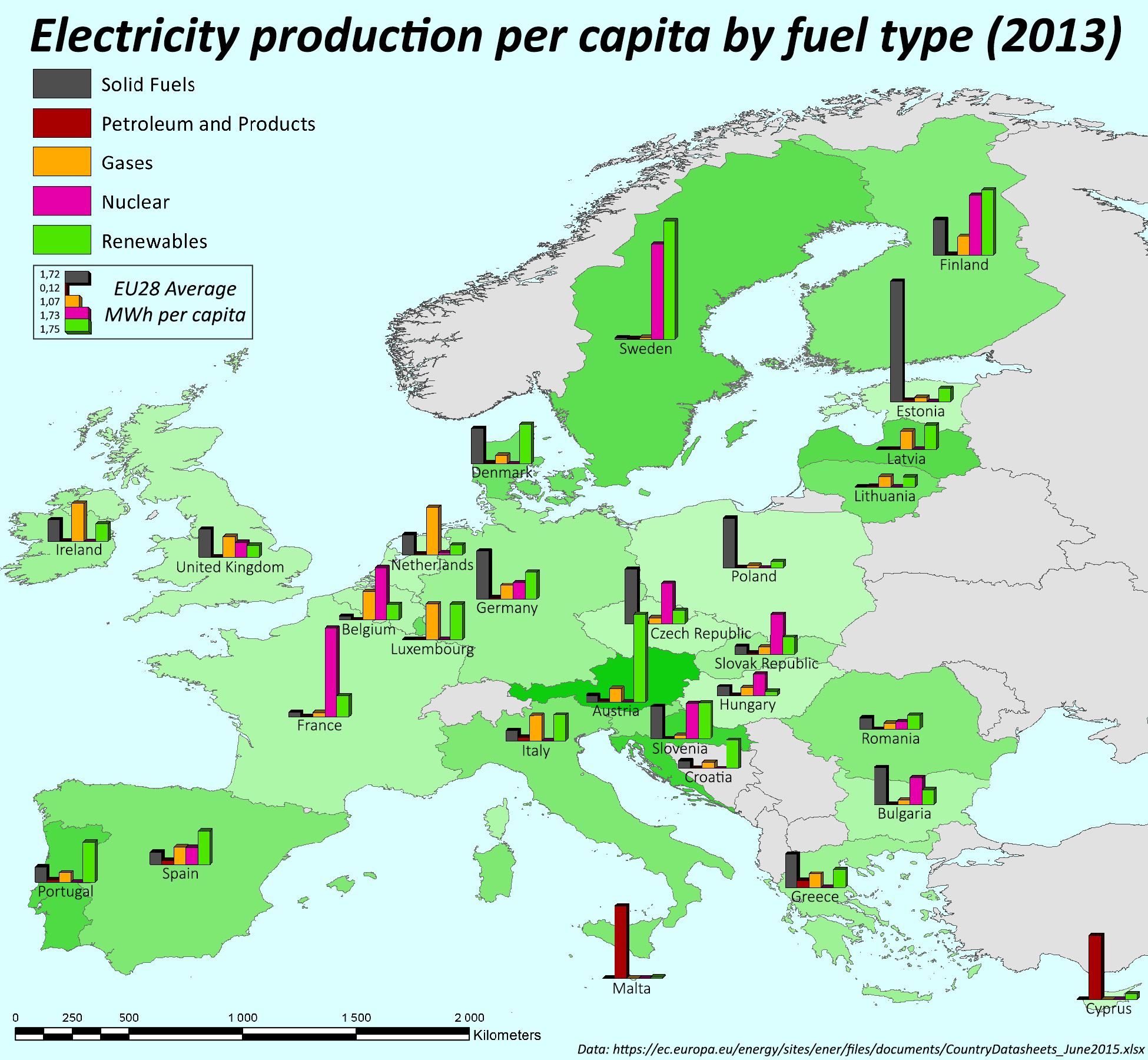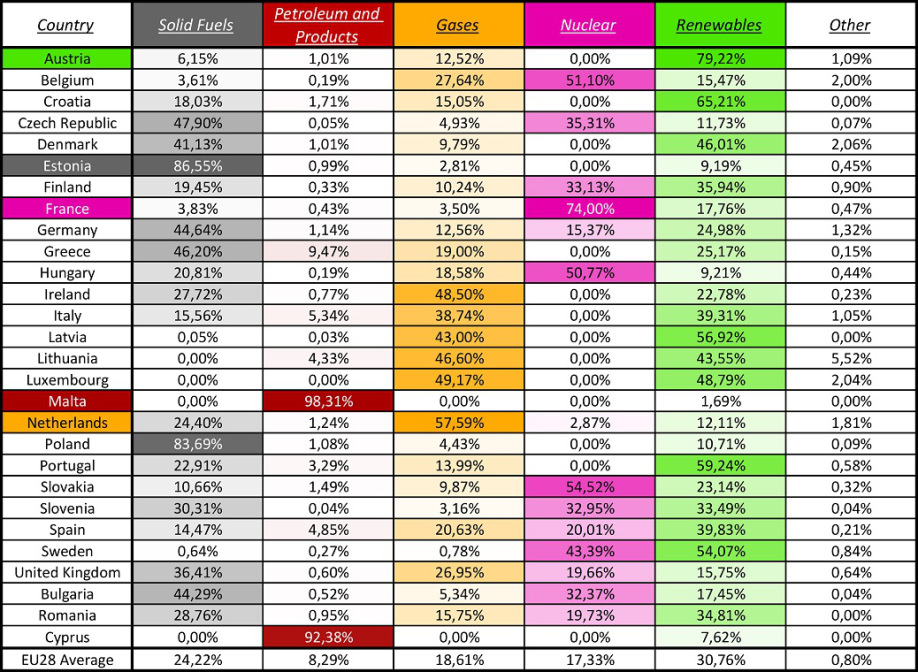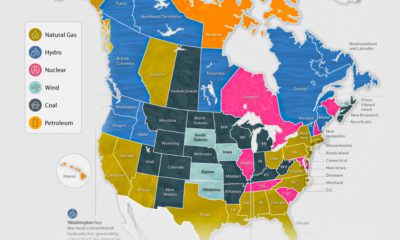The major story here is the decline in consumption of fossil fuels. More specifically, the combined share of petroleum products and solid fuels (meaning coal or shale oil) has fallen from 65.1% of total consumption in 1990 to 50.6% by 2013.
Renewables have steadily increased in consumption since the mid-2000s, and as a result the amount of electricity driven by renewables was 2.8x higher in 2013 (11.8%) than it was in 1990 (4.3%). The energy source that has seen the least fluctuations in usage is nuclear energy. Producing a peak of 14.5% of electricity in 2002, nuclear energy usage has recently dropped back to 13.6% in 2013. Consumption of gas is also an interesting story. Natural gas has been used more prominently in recent years as it became regarded as more environmentally friendly than other fossil alternatives. However, as Europe has tried to reduce dependence on Russian gas, consumption has started to wane since 2010. Here’s how specific countries look in terms of their electricity consumption per capita:
This creates some more granular stories that are worth delving into. Estonia is the country that relies the most on solid fuels, with 86.6% of its energy needs met this fuel type. Interestingly, coal is not the solid fuel that is powering most of the country – that accolade goes to Estonia’s highly-developed and strategic shale oil resource. In this case, shale oil counts as a “solid fuel”, as it is essentially sedimentary rocks with oil trapped in them. Estonia actually has the two largest shale oil power plants in the world, and the industry employs 6,500 people in the country. Malta and Cyprus rely heavily on petroleum products, which account for 98.3% and 92.4% of consumption respectively. This makes sense, as these small island nations do not have the populations or resources to warrant big infrastructure spending on things like nuclear power plants. They simply import what they need, which allows them flexibility. France is the biggest user of nuclear power, with 74% of consumption coming from that source. Belgium, Hungary, and Slovakia have more than half of their power coming from nuclear. Austria uses the most renewable energy with 80%. That said, the vast majority of this comes from hydro, where Austria uses its mountainous terrain to its advantage. Want to dive more into the data? Here it is in its full glory:
Original graphics by: afschakelplan, Eurostat
on
#1: High Reliability
Nuclear power plants run 24/7 and are the most reliable source of sustainable energy. Nuclear electricity generation remains steady around the clock throughout the day, week, and year. Meanwhile, daily solar generation peaks in the afternoon when electricity demand is usually lower, and wind generation depends on wind speeds.As the use of variable solar and wind power increases globally, nuclear offers a stable and reliable backbone for a clean electricity grid.
#2: Clean Electricity
Nuclear reactors use fission to generate electricity without any greenhouse gas (GHG) emissions.Consequently, nuclear power is the cleanest energy source on a lifecycle basis, measured in CO2-equivalent emissions per gigawatt-hour (GWh) of electricity produced by a power plant over its lifetime. The lifecycle emissions from a typical nuclear power plant are 273 times lower than coal and 163 times lower than natural gas. Furthermore, nuclear is relatively less resource-intensive, allowing for lower supply chain emissions than wind and solar plants.
#3: Stable Affordability
Although nuclear plants can be expensive to build, they are cost-competitive in the long run. Most nuclear plants have an initial lifetime of around 40 years, after which they can continue operating with approved lifetime extensions. Nuclear plants with lifetime extensions are the cheapest sources of electricity in the United States, and 88 of the country’s 92 reactors have received approvals for 20-year extensions. Additionally, according to the World Nuclear Association, nuclear plants are relatively less susceptible to fuel price volatility than natural gas plants, allowing for stable costs of electricity generation.
#4: Energy Efficiency
Nuclear’s high energy return on investment (EROI) exemplifies its exceptional efficiency. EROI measures how many units of energy are returned for every unit invested in building and running a power plant, over its lifetime. According to a 2018 study by Weissbach et al., nuclear’s EROI is 75 units, making it the most efficient energy source by some distance, with hydropower ranking second at 35 units.
#5: Sustainable Innovation
New, advanced reactor designs are bypassing many of the difficulties faced by traditional nuclear plants, making nuclear power more accessible.
Small Modular Reactors (SMRs) are much smaller than conventional reactors and are modular—meaning that their components can be transported and assembled in different locations. Microreactors are smaller than SMRs and are designed to provide electricity in remote and small market areas. They can also serve as backup power sources during emergencies.
These reactor designs offer several advantages, including lower initial capital costs, portability, and increased scalability.
A Nuclear-Powered Future
Nuclear power is making a remarkable comeback as countries work to achieve climate goals and ultimately, a state of energy utopia. Besides the 423 reactors in operation worldwide, another 56 reactors are under construction, and at least 69 more are planned for construction. Some nations, like Japan, have also reversed their attitudes toward nuclear power, embracing it as a clean and reliable energy source for the future. CanAlaska is a leading exploration company in the Athabasca Basin, the Earth’s richest uranium depository. Click here to learn more now. In part 3 of the Road to Energy Utopia series, we explore the unique properties of uranium, the fuel that powers nuclear reactors.
































